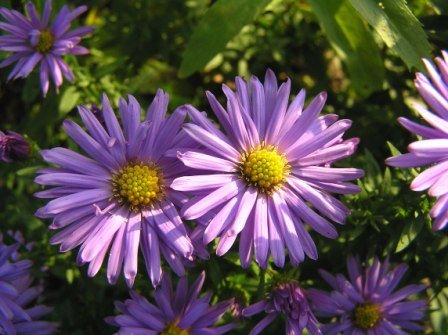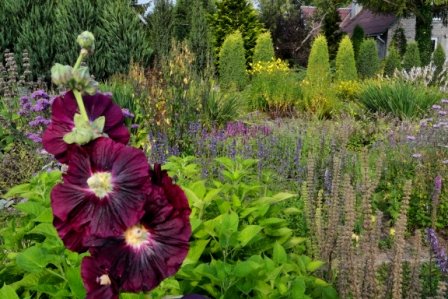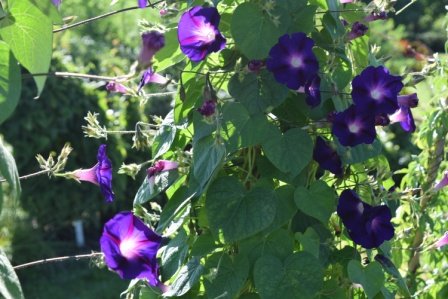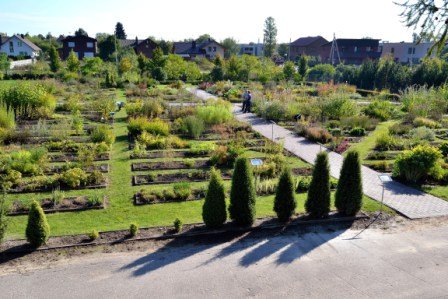The purpose of the Division of Plant Systematics and Geography is to gather a rich collection of outdoor plants, including diverse plant families, genera and species from Lithuania and different geographical regions worldwide, where various educational and scientific research activities could take place.

The division also contains a collection of endangered and rare plants of Lithuania with 70 species, included in the Lithuanian Red Data Book.The division includes over 900 species belonging to 93 families. It contains 118 plant beds which are 1.70–7.65 m. in length and 1 m in width. All plants are sorted by family and in alphabetical order, using the Takhtajan system of plant taxonomy. This type of grouping makes it easier to recognise the morphological characteristics of each plant family.
Among the annual, biennial and perennial plants and subshrubs, cultivated in the garden, the perennial plant species are the most prevalent. It is worth noting that some plant families, such as amaranth (Amaranthaceae), balsam (Balsaminaceae), loasa (Loasaceae), nolana (Nolanaceae), are considered to be annual in Lithuania due to harsh climate conditions. New species are continuously being added to the collection according to their exceptional systematic, morphological and ornamental traits with the primary focus on medicinal, aromatic and rare Lithuanian plants. The biggest collection of plants includes the families of aster (Asteraceae) (109 species), celery (Apiaceae) (57 species), cabbage (Brassicaceae) (57 species), carnation (Caryophyllaceae) (39 species), bean (Fabaceae) (31 species), mint (Lamiaceae) (58 species), grasses (Poaceae) (44 species) and buttercup (Ranunculaceae) (34 species). The most common genera consist of goldenrods (Solidago), carnation (Dianthus), clover (Trifolium) and sage (Salvia).

The origin of division’s plants. The majority of plants of this division are grown from seedsbrought from other botanical gardens by participating in international seed exchange programme. The seeds arrive from various countries, including Austria, Switzerland, Belgium, Germany, France, Italy, Czech Republic, Poland, Latvia, Estonia, Romania and Russia.
Growing conditions
The total area of the division is 25 ares. Most of the plants are grown in beds with the exception of some species that are cultivated in hotbeds. The hotbeds are used for plants that require longer time to reach maturity until they can be replanted. Plants grown in this division do not usually require the soil to be fertile, except for some special occasions. All plants are protected against diseases using natural materials and only a few need to be covered with fir tree branches to survive the cold. The majority of plants are species (not breeds), therefore, they are adapted to survive harsh growing conditions and are very tough.
Fascinating plants
The collection contains plants with decorative as well as aromatic, medicinal, dye-yielding, nutritional and other distinct traits, for instance:
Ferula (Ferulla assa–foetida) is a perennial spice plant belonging to celery (Apiaceae) family. The plant’s leaves, inflorescence and fruits contain essential oil, producing a strong garlic-like smell. Ferula is widely used in Iran and Afghanistan for seasoning various fried and stewed lamb dishes and also in India and Java adding some flavour to rice and vegetables. Ferula is often mixed with curry to introduce a distinct aroma and taste.
Dyers Woad (Isatis tinctoria) is a biennial herbal plant of cabbage (Brassicaceae) family. As the name suggests, the leaves of this plant are used for producing blue dye. According to Julius Caesar (the 1st century BC), British soldiers used to paint their faces with woad to frighten their enemies.
Roseroot (Rhodiola rosea) is a stonecrop (Crassulaceae) family perennial plant with thick succulent leaves and yellow flowers. It is also known as Golden Root for its shiny golden appearance. It is believed that roseroot accumulates a substance that improves health, revitalises the body and restores a weakened immune system. Due to its remedial properties roseroot is often associated with ginseng.

The division also grows alluring perennial herbs and subshrubs belonging to mint (Lamiaceae) family. Some plants have unique shapes and blossoms of blue, cerulean, purple colours and hues. Plants belonging to the genera of hyssop (Hyssopus), sage (Salvia), catmint (Nepeta), horse-mint (Monarda) woolly sage (Phlomis), betony (Stachys) have very attractive flowers that bloom from June to September. There are many other charming ornamental plants with unique forms and leaves’ structure that are worth observing until October.
The blooming season (from June to October) is the best time to visit as the plants flourish with blossoms and leaves of different shapes. Among the most beautiful flowers grown in this division are annual ornamental plants belonging to bindweed (Convolvulaceae) family. The most prevalent representatives of this family are morning-glories (Ipomoea). The stems of morning-glories can grow more than 2 meters in height. The colours of flowers vary from sky blue to burgundy, rose, florid, white and multi-coloured. The flowers bloom from June to October. Apart from beautiful blossoms, the plants of this division have decorative leaves that are heart-shaped, with pointy tips and often trilobate.

Short history. In the year 2000 new plant collections were started under the guidance of the garden director prof. Vida Motiekaitytė. The collection belonging to this division was also included among the planned collections. In 1999 agronomist Rita Mikaliūnaitė, who had been taking care of other plants in the garden, helped to form the division and a year later the project to create the Division of Plant Systematics and Geography was put into action. The first plants of the division were planted in the spring of 2002. One of the main reasons to create the division was to ensure the high quality studies of plant systematics for Šiauliai University students. Another reason was to show the variety of Lithuanian flora, plant families, genera and species from diverse geographical regions worldwide and present plant system to garden guests giving them the opportunity to learn about medicinal, aromatic and endangered representatives of Lithuanian flora. Šiauliai Botanical Garden staff: Rita Mikaliūnaitė (1999–2006), Edita Lopetienė (2006–2009), Roberta Dubosaitė-Lepeškevičė (2009–2016) have contributed greatly to the division’s development.
Division supporters. Kęstutis Kazimieras Vilkonis has shown great contribution towards retaining and improving the division by taking the initiative to create the collection of endangered and rare plants of Lithuania. The plants for the collection were brought from expeditions, organised by Kęstutis Kazimieras Vilkonis, which focused on gathering data and taking photographs for the atlas named “Lietuvos žaliasis rūbas” (the green robe of Lithuania).
The installation of pavement in the division was funded by Šiauliai Rotary club “Harmonija”.
The pictures of blooming plants and beautiful landscape of the division were taken by a volunteer photographer Romualdas Struoga.
The division is administered by the supervisor of botanical collections Žydrūnė Valainytė, e-mail:
